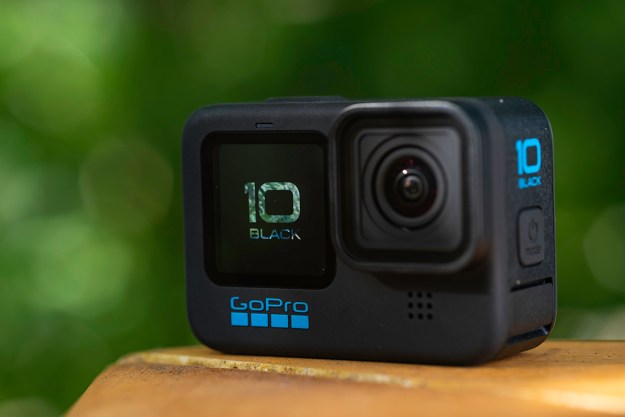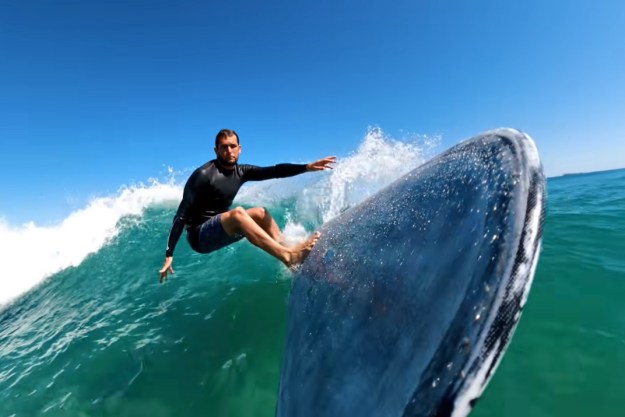Hold it, wear it, mount it, and forget about it
As the Karma Grip is designed specifically for the GoPro Hero6 and Hero5 Black cameras (Hero4 cameras are supported with an optional harness), all you need to do is plug in the camera and latch the housing, and you’re good to go. There’s no balancing required. This also means, of course, that you can’t adapt the Karma Grip to work with other types of cameras, whereas some third-party gimbals can be balanced for multiple brands and models.
The Karma Grip is dirt-simple to use for just about anyone.
If you’re not already a GoPro owner, you’ll need to factor the cost of a Hero5 ($400) or Hero6 ($500) into your budget if you want to use the Karma Grip. If you are simply looking for a handheld gimbal camera, you might want to check out our review of the DJI Osmo+, which pairs a bespoke camera and gimbal together for just $649 (or consider the Osmo Mobile, a gimbal for your smartphone, that goes for $299).
The positive here is that the Karma Grip is dirt-simple to use for just about anyone, even without any prior experience with video stabilizers. It’s clear that simplicity was GoPro’s primary goal, and anyone can pick this up and just start shooting with it.
We also like how you can control the GoPro straight from the Karma Grip handle. You can start and stop recording, change shooting modes, and even add markers to the video as you’re shooting. The camera automatically powers on and off with the gimbal, and you can plug the grip straight into your computer without detaching the camera to transfer files. This will also recharge both the grip and the camera as one. (GoPro claims two hours of runtime on a charge, which definitely seems on the low end. The battery is also not replaceable.)
If you’d rather take a hands-free approach, there are various options for mounting the gimbal. The Karma Grip is designed to be used equally effectively as a hands-free device, and that’s certainly of benefit to many GoPro camera users. Clip it to a backpack strap or mount it to a helmet using the optional Karma Grip Extension Cable.
It is also relatively well made, and while we didn’t crash a mountain bike with it or run it into a snowdrift, we did take it out in the rain for an extended period of time without issues.
It’s a good first try, but it’s still a first try
The focus on simplicity brings about some shortcomings. This is clearly a device GoPro wants people to just turn on and use without giving it a second thought, and that’s probably fine for a lot of users. We would have liked to see more manual controls.
There’s really only one basic operational mode, which locks the pitch and roll angles but allows the yaw, or pan, axis to rotate with the user. This makes for very smooth pans, and is generally the behavior people would expect from a gimbal, but it also lacks customizability.
You can hold the padlock button to allow both pan and tilt to follow your motion, but this only works while the button is held, which can be a bit awkward. Fortunately, the gimbal will remember the tilt angle when you release the button and maintain that angle until you change it. Simply pressing the button will reset it to its default position.
It would have been much nicer to simply have a joystick to set pan and tilt angles, which is how most other gimbals work. It would also have been nice if there were some other modes, like one that locked every axis instead of allowing the camera to pan. There just isn’t a lot of control here but, again, maybe that’s fine for most folks.
Also, the Karma Grip cannot rotate a full 360 degrees on any axis. This leads to some sudden camera angle changes during more extreme motions when you bump up against a stop point. Nor can it rotate into a reverse-facing position. For better or worse, that means no selfies unless you actually turn the handle around — and then the buttons are on the wrong side, of course. All of this might be forgivable, but 360-degree rotation and a four-way joystick are both features offered on competing third-party models, like the Feiyutech G5, which is also less expensive.
Rock steady? Sorta
Then there’s the issue of the quality of the stabilization itself. While the Karma Grip generally does an admirable job creating smooth video, it does have a tendency to roll under minor lateral acceleration. If you’re walking around a corner, the camera begins to bank to one side. We initially found this issue to be pretty bad, and it would only correct itself after we came to a complete standstill and remained stationary for several seconds. We updated to the latest firmware, version 1.5.1, which helped out a bit, although it didn’t completely fix the issue. Interestingly, the effect seems less pronounced with more extreme motion (or at least less noticeable); if you primarily use your GoPro for the extreme activities it’s intended for, this may be a nonissue.
It’s very much a version 1.0 product.
Our final complaint has to do with the noise. The electric motors have a very noticeable buzz when turned on. Honestly, it’s more annoying while using the gimbal than it is during playback, as the sound is only audible in the video file if you’re filming in a very quiet environment — not how most people use action cameras. Still, anyone worried about pristine audio may have some concern.
In short, the Karma Grip is a decent stabilizer that should work well for GoPro’s primary demographic. But it is also very much a version 1.0 product, with several small issues we would like to see resolved in a future version. If you’re looking for a basic, no frills stabilizer for your GoPro, then it’s a solid choice. But if you want more control or absolutely perfect stabilization — or if you simply want to save a few bucks — hold off or look elsewhere.
Editors' Recommendations
- Best GoPro deals: Save on action cameras and accessories
- The 4 best GoPro alternatives in 2024
- GoPro Hero 11 Black leak suggests a moderate upgrade
- ReelSteady makes GoPro Player ‘reel’ useful for filmmakers
- GoPro keeps recording as parrot steals it from tourists and flies off






